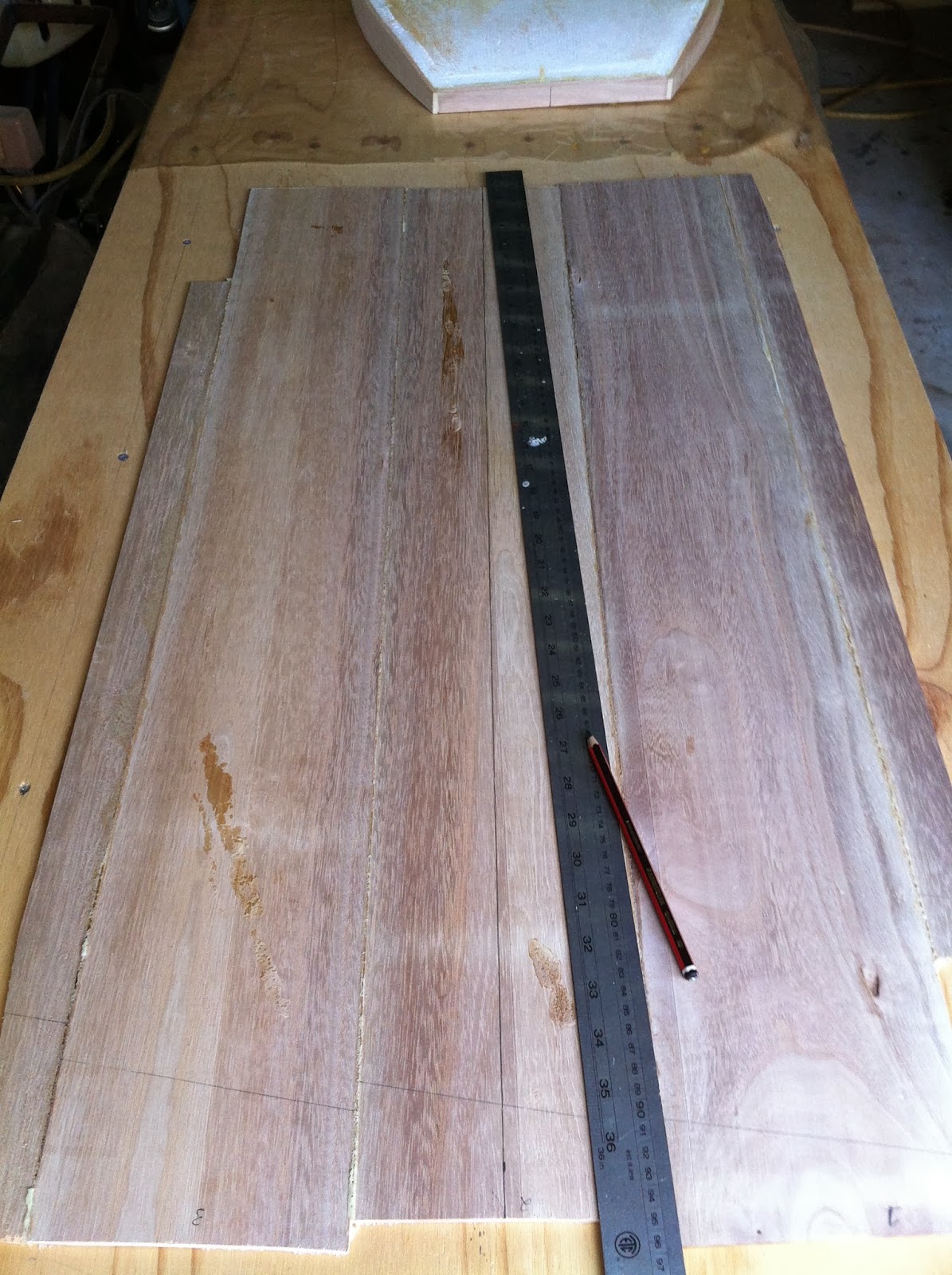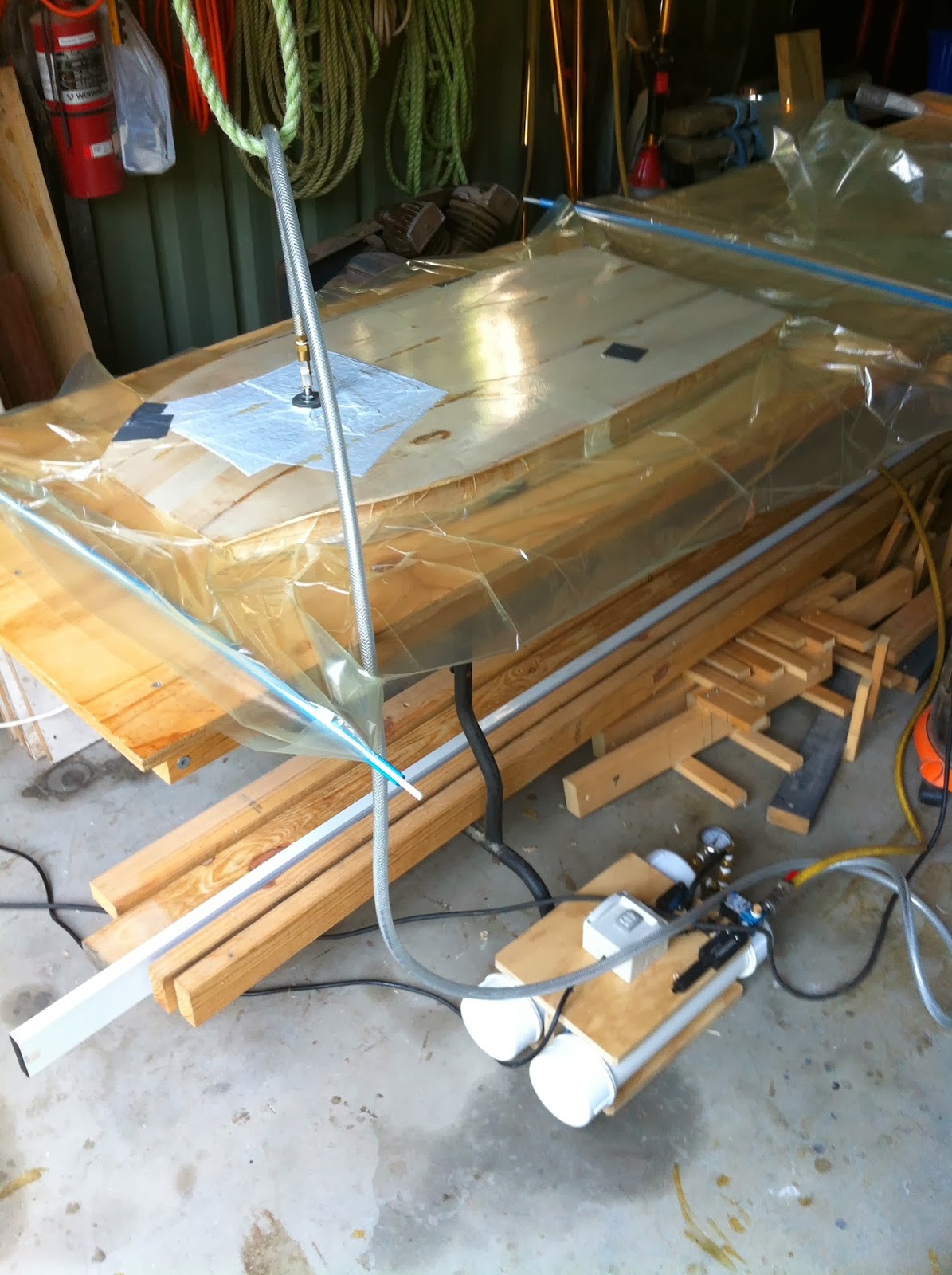Namaste Log Dodgers and welcome to this installment of building a Wood Boogie Board. Yes, you guessed it. I've got the boogy fever, I thinks it's going around.
I was recently checking out the surf at Currimundi on the Sunny Coast. It was on-shore, messy garbage wind swell and not worth getting my woody wet. Very disappointing really. But as I made my way back to the Buddha Mobile I spied something out of the corner of my little eye, something beginning with "B". It was a rather sad looking boogie board discarded in the car park rubbish bin. The skins were half pealed off, it was covered in wet sand and it looked in a very sorry state. The foam core was in relatively good condition so I thought to myself, "Wood Buddha, here's a fine instrument of surf sport on the down and out. Time to use your skills for good and give this puppy a new lease of life". It's time for a Boogie Board extreme makeover.
Enter my latest project. So I rescued the foam core, brought it back to the ashram and started work on recycling the old bugger. I had a heap of 4 mm thick paulownia off-cuts lying around which were perfect for the skins and rails so I pulled up my trousers, zipped up my fly and made a start.
The first step was to mark and trim the tail straight using a sharp craft knife.
Then I sanded the sides, front and back square with 80 grit sand paper with my custom made sanding block.
The custom made sanding block keeps the edges perfectly square to the deck.
I made a jig out of scrap pine to glue the rails to the foam. I'll also use this jig to shape the rails after I steam them.
Gluing on the nose block with Polyurethane glue.
And the tail block.
The glue is dry after 2 hours and the nose and tail strips are ready for trimming.
Trimming the top and bottom edges of the nose and tail strips with my palm plane.
The ends are trimmed with a dovetail saw and finished with sand paper.
Trimmed up and ready for the rails.
The first rail getting glued onto the right hand side of the board. The rail on the opposite side has no glue on it and is just being used to stop the straps cutting into the foam. The two large timber blocks on the top and bottom of the bottom of the foam help to keep the board nice and flat as the foam core had a slight bow in it.
Gluing the second rail onto the opposite side.
The glue is dry and the rails are ready for a trim.
Trimming the rails with my palm plane. I use a sanding block to clean up the ends.
All trimmed up and ready for the top and bottom skins.
A photo of the under side.
Taping up the top and bottom skins using the tape and hinge method. The tape on either side of the join stops the glue from spreading onto the panel and making a mess.
Taping the other side of the panel. This tape join forms the hinge.
Hinging the tape join over the edge of my work table and applying a thin bead of polyurethane glue.
I then place plastic sheeting over the panel, a sheet of ply and special clamping bricks to keep it all flat.
The glue dry and the tape ready to be removed. After the tape is removed there is very little sanding required. The joins are nice and neat.
Marking a centre line on the skins. This helps with lining up the foam core with the panel.
The centre of the nose piece on the foam core.
Laying the foam core on the panel and marking the outline with a pencil. I allow an extra 5 mm overlap.
The panel marked to the outline of the core and ready for cutting.
A sharp craft knife cuts the paulownia easily.
Cut and ready for sanding. There are two of these panels. One for the top of the board and one for the bottom.

Finishing with an orbital sander. 80 grit then 120 grit then finished with 180 grit.
Applying Poyurethane glue to the top of the board. I leave it to foam up for about 5 minutes before taping on the top panel and placing the board in a vacuum bag. I did the top panel first then the bottom panel later. Ideally it's best to glue both panels at the same time as the vacuum bag tends to flatten the low density foam.
In the bag with the bejesus sucked out of it. I use a vacuum pressure of about 15" of Hg.
Out of the vacuum bag after 2 hours.

Bending the nose of the bottom panel using a steam iron. Firstly I wet the timber with some wet towels for about 10 - 15 minutes. Then heat the panel with the steam iron as I bend the tip of the panel with my hand. I then clamp it in place for a couple of hours (ideally overnight) using a piece of timber and a clamp.
Polyurethane glue is spread on the foam on the bottom of the board and left to froth for about 5 minutes. The bottom panel is taped in place and it's all put in the vacuum bag for about 2 - 3 hours.
Out of the bag after 2 -3 hours and ready for a trim.
Steaming the cedar and paulownia rails for one side of the board.
The rails are clamped in a jig while the timber is pliable from the steam. I leave the rails in the jig for a couple of hours.
The first cedar rail band is glued in place with polyurethane glue. This rail will be a feature strip.
I used a steam iron to bend the cedar rail on the other side and taped it in place while the timber cools. Using the steam iron to bend the timber is a lot simpler than using my steam box. I wet the timber first with wet towels.
Gluing the cedar rail on the opposite side using polyuretahne glue and holding it in place with tape and a couple of straps.
After the glue has dried (2-3 hours), I trim the ends of the rails. It's then ready for the nose and tails pieces.
Gluing the cedar nose and tail pieces.

Trimming the cedar nose and tail pieces once the glue has dried.
The paulownia rail glued to the left hand side of the board. I bent it using the steam iron before gluing it in place.
The paulownia rail glued to the right hand side of the board. I bent it using the steam iron before gluing it in place.
Trimming the ends of the rails with a dovetail saw and sanding block.
Gluing the tail and nose pieces in place.
The final rail bands going on. One on the right.
One on the left.
Out in the sunshine getting nice and warm and ready for a coat of lanolin grease.
All finished and ready for a test drive.

Finishing with an orbital sander. 80 grit then 120 grit then finished with 180 grit.
In the bag with the bejesus sucked out of it. I use a vacuum pressure of about 15" of Hg.
Out of the vacuum bag after 2 hours.

Polyurethane glue is spread on the foam on the bottom of the board and left to froth for about 5 minutes. The bottom panel is taped in place and it's all put in the vacuum bag for about 2 - 3 hours.
The venturi vacuum pump and bag setup. The venturi vacuum pump is connected to my compressor.
My weapons of choice for cleaning up the nose, tail and rails. The next stage is to glue on the rails, nose and tail blocks.
Taping up the top and bottom of the board. The tape protects the timber from glue spills.
The rails are clamped in a jig while the timber is pliable from the steam. I leave the rails in the jig for a couple of hours.
The first cedar rail band is glued in place with polyurethane glue. This rail will be a feature strip.
I used a steam iron to bend the cedar rail on the other side and taped it in place while the timber cools. Using the steam iron to bend the timber is a lot simpler than using my steam box. I wet the timber first with wet towels.
Gluing the cedar rail on the opposite side using polyuretahne glue and holding it in place with tape and a couple of straps.
After the glue has dried (2-3 hours), I trim the ends of the rails. It's then ready for the nose and tails pieces.
Gluing the cedar nose and tail pieces.

Trimming the cedar nose and tail pieces once the glue has dried.
The paulownia rail glued to the left hand side of the board. I bent it using the steam iron before gluing it in place.
Trimming the paulownia rail band.
The paulownia rail glued to the right hand side of the board. I bent it using the steam iron before gluing it in place.
Trimming the ends of the rails with a dovetail saw and sanding block.
Gluing the tail and nose pieces in place.
Trimming the second set of rails with a palm plane.
One on the left.
Gluing on the tail and nose pieces. Once the glue has cured, the top and bottom edges of the rail bands, nose and tail pieces are all trimmed. The rails are shaped and the entire board is given a final sand with 240 grit sand paper.
All finished and ready for a test drive.
































 wood boogie board
wood boogie board


























